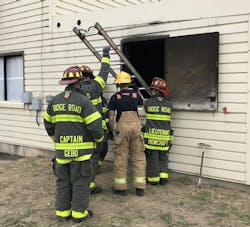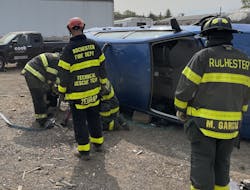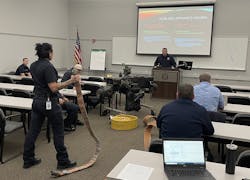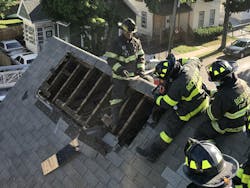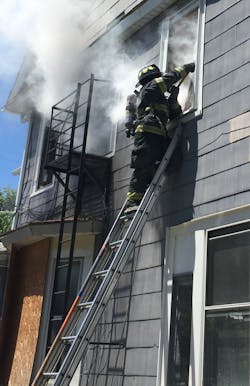Six Considerations for Improving the Company-Level Drill
Think about a memorable drill that covered a skill or new information that still sticks with you. What made the drill that way? Common answers are: a prepared instructor; clear objectives; various learning methods, including knowledge and practical sessions; fun; interactive; and a positive and respectful learning environment.
What follows are six elements for the fire officer and fire instructor to consider to increase the probability of building and conducting a successful drill or training session to make it applicable and memorable: write an objective, design the drill, preparation, good instruction, student engagement and practice/application. “Successful” is defined as meeting the principles of adult learning and resulting in a well-received learning experience that has lasting knowledge or skill retention for the participants.
Write an objective
This element of building and conducting a successful drill is the most important for the training session. To begin to develop the drill objective, ask yourself (or the training requestor):
• What do I want the students to know or do?
• What do I need to make the drill happen?
• How do I know that the students understand the objective of the session? (Or how do we know that you’re done?)
The answers to these questions are vital to framing the drill and to helping the trainer to identify the type of training session: hands-on, coffee table, classroom, tailboard, etc. For example, if you want students to throw a 24-foot portable ladder, then that’s a hands-on drill. If you want them to list the classes of fire, that might be a classroom or coffee table session.
There are numerous approaches to writing a training objective, but a simple, easy-to-structure method that’s found in current “Fire and Emergency Services Instructor” textbooks uses an A-B-C-D acronym:
• A = Audience—identifies who will be engaged in the training session
• B = Behavior—what you want participants to know or do
• C = Condition—how they will do it or with what information or circumstance (can be expanded to include when or where)
• D = Degree—how well or to what identified criteria
A real-world example of a simple A-B-C-D training drill is: Audience: the firefighter; Behavior: deploy a two-section, 24-foot portable ladder from Engine 1 to a second-story window; Condition: in full PPE; and Degree: successfully complete the task within 45 seconds.
Taking the time to consider the objective and to develop it into a written form is crucial to building and conducting a successful drill. It sets everything else into motion by setting the boundaries of the training session and the learning goal post, to inform trainers when they are done and when the learning goal was accomplished.
Design the drill
Build or design a drill that aligns with adult and workplace learning practices. If the objective of the drill allows, the training should be problem-centered and engaging.
Many adults prefer how-to content. This works in the favor of the trainer, because most firefighters report possessing a hands-on bias toward learning: They want to “do” to become competent.
Make sure that what the firefighters learn is relevant to their job duties and transfers to the workplace.
The training session should allow for knowledge synthesis, absorption of information (how many facts), and time for practice and application of the new knowledge or skills.
This element of running successful drills usually coincides with the development of a written lesson plan for the session. It allows you to alter past drills and to build a new drill to be as engaging as possible, to work toward lasting learning.
During the design phase, sketch out the timeline of the drill. What steps exist from the beginning to the end? How does the drill start, what happens during the middle of the drill, and how does it end?
Research the topic and explore the current literature. Ensure that the training staff presents factual and current information from department polices/standard operating guidelines (SOGs), manufacturer information and textbooks compared with the internet and YouTube.
Conduct the course with the firefighter’s safety in mind. Adhere to department policies and procedures, national standards, and cold- and hot-weather guidelines. Require the use of PPE that’s appropriate for both the participants and the instructors.
Another consideration of firefighters’ safety applies to the learning environment and students’ ability to make mistakes (while not putting anyone in harm’s way), to ask questions and to ask for assistance while they operate in the learning environment.
The design stage affords training session developers to try something new and to tap into their creativity and ingenuity. Is there a way to improve on past iterations of the training session?
Preparation
Allot time—from inception of the drill to the moment before the drill begins—to address the planning elements. It’s during this time that you identify why members are participating in the training and begin to visualize your rough training objective(s). “Writing an objective”and “designing the drill” likely are addressed during the planning period. Understanding why firefighters are involved in the training session is key to further development. Is the drill intended to provide new information or to review a topic?
Now, you can begin to gain a handle on the time requirements for planning the session. Are you planning on reusing or recycling an existing lesson, or must you commit time to develop a new lesson from scratch? Also, review existing training materials to see whether they remain appropriate or might be nearing (or past) the end of useful life.
It’s vital to conduct an audience analysis that’s based on the available participant information. Identifying what you know about the students, why they are in attendance, years of service, current assignments and other pertinent information allows the training session to be tailored in a way that makes the most sense for the participants.
It also is important to identify the probable lesson needs at this phase of preparation. This encompassing component requires the trainer to identify what facility requirements exist; to make requests for equipment; to reach out to their property and/or manufacturer contacts; to ensure permissions are obtained; and to ensure that everything that’s involved in the training will run smoothly.
Planning includes ensuring that instructors are on time and the site is ready. Adult learners’ time is valuable. The relationship between instructor and learner gets off to a rough start when the session begins unacceptably late or is disorganized from the first moment.
It’s worth noting that it’s in the training staff’s best interest to have a backup plan in case of foreseeable and unforeseeable events (e.g., weather issues, late or in-service personnel, training site changes).
Good instruction
In professional development training, I ask participants about the characteristics of the best instructor who they encountered, so I can emulate those characteristics. Even when participants present characteristics of their worst instructors, there is valuable information.
Research on exemplary instructors goes hand in hand with answers that students provide when asked about their best instructors.
• Knowledgeable of and experienced with the subject they present. Good instructors stay up to date on topics that they teach and anticipate/answer common questions associated with the topic. They explain well and relate theory to practice and vice versa.
• Prepare for teaching as a serious endeavor. Such instructors put in advance work to build a worthy session and make adaptations after to ensure future iterations are the best that they can put forth.
• Expect a lot from students. A drill doesn’t have to be “easy” or quick to be good. A good instructor sets expectations for the training session commensurate with the knowledge, skills and abilities that the firefighters are expected to achieve and perform. The learning environment should cause students to think.
• Trainings are fair to students. This characteristic also is found in the fire officer and leadership literature. It’s important to hold students to a standard and to apply that standard uniformly.
• Check on student progress and provide feedback and evaluation.
• Passionate about sharing information. Good instructors develop an exciting drill, but even a boring drill can be made better by instructors who instruct passionately. They care about the job, the topic they teach, and the student learning and improving.
Student engagement
When you conduct a company-level drill, it’s vital to consider the elements of engagement and participation. You mustn’t consider firefighters as empty vessels that are filled with all of the information that you have in your lesson plan. A drill should be purposefully designed to engage the learners and hit multiple aspects of learning characteristics and preferences.
There is some controversy over whether the traditional distinction of learning styles is an appropriate learner characteristic, but, anecdotally, some students recall more efficiently when they see and read, while others might recall information better when they hear then do. If a firefighter who will participate in a training expresses preference for a specific style of learning, you might be able to accommodate that style during the training session.
Improve student engagement
To improve the company-level drill, the instructor should be on the lookout for new tools, techniques, technology and methods to improve student engagement. Some suggestions for improving engagement are:
Build the drill to be hands-on. A simple way to structure a drill is to have participants See-Think-Do. Participants should see the new information or skill, think about it and ask questions, then keep doing it with feedback and coaching until they meet levels of proficiency.
Allow members to find answers and information. Learner success might improve when the trainer poses a question or fire/rescue problem and allows firefighters to find answers. The youngest members always had search engines at their disposal and might be able to find relevant information that way. Other sources of information to structure “finding information” exploratory sessions include SOGs and manufacturer documents.
Consider what’s known about attention span. A solid number for learning environment attention span is about 15–20 minutes.
TED Talks are capped at 18 minutes. This is based on research into how much information the brain can acquire, or cognitive load. This doesn’t mean that a training session can’t exceed 18 minutes, but it does indicate that the trainer should consider switching passive instructional methods (lecture, reading, telling, etc.) or adding activities and hands-on more regularly around the 15–20-minute mark.
Finally, we can engage for longer than 20 minutes when we are interested and invested. Consider the time commitments that you invest in a documentary or a movie when you find the content interesting and engaging.
Practice/application
To reiterate, most skills and concepts that are critical for firefighters to learn/perform at a drill should be developed through practice and applying the skills appropriately.
For essential fireground tasks, allow participants the repetitions they need to perform the skill at an acceptable level. Set expectations above meeting minimum standards, to ensure they excel at the task.
Once the skill is mastered, you might find that it’s in participants’ best interest to move into a scenario in which they must demonstrate the acquired (or improved) skill.
During the drill, the instructors’ role may transition between that of teacher giving information and that of coach helping the participant to develop competence.
Long-lasting
These six elements are considerations for improving a drill the next time that you are charged with conducting the company-level training session. Use your own touch to incorporate these elements to capture attention, engage body and emotion, cause thinking and result in significant learning that lasts beyond the drill’s time frame.
Adults as Learners
Malcolm Knowles was an American educator who put forth a group of principles and assumptions that define adults as learners. His work promotes that adults as learners:
1. Need to know what, why, how. To do this, ensure that the training session is relevant to participants’ work and that you are able to answer these questions when asked.
2. Are heavily self-directed. They want to learn on their own and work independently and autonomously.
3. Come with prior experiences. Instructors might be able to build on participants’ existing knowledge or skills and work with them to smooth out any bad habits that they developed.
4. Are problem-oriented. Can the training session be designed so that the participants must think about the possible solutions and
arrive at an answer?
5. Require feedback. Feedback can take many forms. It can be written or verbal, formal or informal. For many fire service drills, feedback is given as verbal, informal feedback to let firefighters know how they are doing. Highlight and encourage what they are doing correctly and offer correction or alter practice when they are doing something incorrectly. Make sure that you can explain why something is incorrect and can show them the correct way.
6. Learn differently. Each member of a fire department possesses different learning characteristics, such as preferences, speed/retention and styles. Learner characteristics are all of the parts that make up the individual—time in the fire service/experience, ability, background, etc. Learner speed relates to how quickly the learner is able to acquire and use the new knowledge or skill; retention correlates to how long that the learner will maintain the skill or remember the information.
About the Author

Edward Tracey
Edward A. Tracey, Ed.D., is a 30-year member of the fire service who has served the past 20 years with the Rochester, NY, Fire Department. He serves as the Rescue Co. captain, including additional responsibilities tied to collaborative management of the department’s technical rescue training, response and typing programs. Tracey also serves as a fire service and technical rescue instructor for a statewide training system, sits on numerous curriculum development committees and serves as an adjunct professor. He has a doctoral degree in education from the University of Rochester, a master’s degree in public administration from SUNY Brockport and a bachelor’s degree in fire service administration from the University of New Haven.
